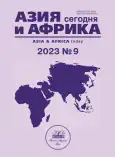ОАЭ в борьбе за региональное лидерство
- Авторы: Хайруллин Т.Р.1,2, Коротаев А.В.3,4
-
Учреждения:
- Институт Африки РАН
- Финансовый университет при правительстве РФ
- заведующий Лабораторией мониторинга рисков социально-политической дестабилизации НИУ ВШЭ, ведущий научный сотрудник Института востоковедения РАН
- профессор факультета глобальных процессов МГУ имени М.В.Ломоносова (ФГП МГУ)
- Выпуск: № 9 (2023)
- Страницы: 27-35
- Раздел: Политика, экономика
- URL: https://journals.rcsi.science/0321-5075/article/view/141090
- DOI: https://doi.org/10.31857/S032150750027592-3
- ID: 141090
Цитировать
Полный текст
Аннотация
Ключевые слова
Об авторах
Тимур Радикович Хайруллин
Институт Африки РАН; Финансовый университет при правительстве РФРоссийская Федерация, Москва
Андрей Витальевич Коротаев
заведующий Лабораторией мониторинга рисков социально-политической дестабилизации НИУ ВШЭ, ведущий научный сотрудник Института востоковедения РАН; профессор факультета глобальных процессов МГУ имени М.В.Ломоносова (ФГП МГУ)Российская Федерация, Москва
Список литературы
- Сейранян Б.Г., Исаев В.А., Филоник А.О. Становление государственности Аравийских монархий. М.: ИВ РАН, 2013. 180 с. ISBN 978-5-89282-563-4
- Rugh A.B. 2007. The Political Culture of Leadership in the United Arab Emirates. Palgrave Macmillan.
- Васильев А.М., Хайруллин Т.Р., Коротаев А.В. Новый альянс в борьбе за лидерство в арабском регионе. Азия и Африка сегодня. 2019. № 10. С. 2–9. doi: 10.31857/S032150750006519-2
- Ibish H. 2017. The UAE’s evolving national security strategy. Arab Gulf States Institute in Washington. Issue Paper. Vol. 4.
- Hasan Z. 2010. Dubai Financial Crisis: Bailout and After. A Case Study. Journal of Islamic Banking and Finance. № 26397.
- Islam M. 2009. The Dubai Debt Debacle: Likely Impact on South Asia. Institute of South Asian Studies.
- Helliwell J., Layard R., Sachs J. World Happiness Report 2017. 14.04.2023. https://wellbeingintlstudiesrepository. org/cgi/viewcontent.cgi?article=1005&context=hw_happiness (accessed 14.04.2023)
- Мелкумян Е.С. Космическая деятельность ОАЭ: разрушение стереотипов. Мировая экономика и международные отношения. 2022. № 5, с. 78–87. doi: 10.20542/0131-2227-2022-66-5-78-87
- O’Brien E., Sinclair A. The Libyan War: A Diplomatic History. February–August 2011. New York.
- Васильев А.М., Исаев Л.М., Коротаев А.В., Кожанов Н.А., Мардасов А.Г., Семенов К.В., Хайруллин Т.Р. Схватка за Ближний Восток. Региональные акторы в условиях реконфигурации ближневосточного конфликта. М.: ЛЕНАНД, 2019, 256 c. ISBN 978-5-9710-6798-6
- Хайруллин Т.Р. Борьба за лидерство в Арабском регионе. Есть ли шанс для исламистов? М., ИАфр РАН, 2019. 214 с. ISBN 978-5-91298-243-9
- Freer C. 2016. Is the UAE’s Fear of the Muslim Brotherhood Driving Its Yemen Strategy? London.
- Хайруллин Т.Р., Коротаев А.В. Катарско-турецкий и саудовско-эмиратский блок: борьба за влияние в Судане. Азия и Африка сегодня. 2022. № 4. С. 29–36. doi: 10.31857/S032150750019730-5
- Chandrasekaran R. 2014. In the UAE, the United States Has a Quiet, Potent Ally Nicknamed ‘Little Sparta’. 09.11.2014. https://www.washingtonpost.com/world/national-security/in-the-uae-the-united-states-has-a-quiet-potent-ally-nicknamed-little-sparta/2014/11/08/3fc6a50c-643a-11e4-836c-83bc4f26eb67_story.html (accessed 12.04.2023)
- Хайруллин Т.Р., Коротаев А.В. Борьба между катарско-турецким и саудовско-эмиратским блоком за влияние в Афганистане. Контуры глобальных трансформаций: политика, экономика, право. 2022. Т. 15. № 2. С. 240–252. doi: 10.31249/kgt/2022.02.13
- Мелкумян Е.С. Израиль во внешней политике ОАЭ: от конфронтации к нормализации. Вестник МГИМО-Университета. 2021. Т. 14. № 2. С. 107–118. doi: 10.24833/2071-8160-2021-2-77-107-118
- Васильев А.М. Персидский залив в эпицентре бури. М.: Политиздат, 1983. 288 с.
- Васильев А.М. От Ленина до Путина. Россия на Ближнем и Среднем Востоке. М.: Центрполиграф, 2018. 670 с. ISBN 978-5-227-07511-6
Дополнительные файлы











